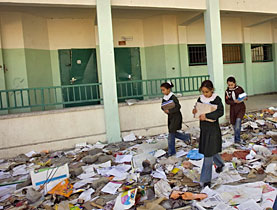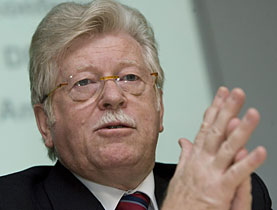Swiss refocus humanitarian aid

New challenges including climate change and migration will characterise how humanitarian aid is delivered, Foreign Minister Micheline Calmy-Rey said on Friday.
But speaking before the annual conference of the humanitarian aid unit of the Swiss Agency for Development and Cooperation (SDC), Calmy-Rey employed imagery from a long-standing conflict.
“We were all shocked to see these images,” the foreign minister said in Bern against a backdrop of images from January’s conflict in the Gaza Strip. Apart from roughly 1,400 dead, Calmy-Rey said Gazans were left “without hope, without a solution”.
In her address to some 900 delegates, Calmy-Rey spoke in strong terms about the problems Swiss aid workers encountered in Gaza. She described diplomatic activity to allow access to territory for the Geneva-based International Committee of the Red Cross (ICRC) as “intensive”.
“When you need diplomacy for doctors to get to the wounded, assistance often comes too late,” she said. But the foreign minister also sought to explain a strategy for development that was more focused and more expertise-driven.
The government wanted to focus its resources “where the need is particularly great and where we have sufficient expertise,” Calmy-Rey said.
In 2008 Switzerland earmarked SFr2.21 billion ($1.93 billion) for official development assistance, a nine per cent increase over the previous year. But the SDC has reassigned 340 employees, shuffled 700 projects, will pare down its list of priority countries from 17 to 12 by 2012 and will end a small humanitarian programme in North Korea.
“Starting point”
“The starting point for this discussion was the broader debate on aid effectiveness,” Martin Dahinden, the SDC’s director, told swissinfo on Friday.
“If you look at international cooperation, you see quite a significant fragmentation – countries being involved in an enormous amount of places.”
The result was that countries used more resources to organise programmes than on beneficiaries. “Against this backdrop, there was a strong pressure in the government and in parliament to reduce the number,” he said.
“There are very different kinds of considerations behind it. I would not be honest if I said political considerations do not play a role. The rule of law and human rights on one side and development on the other are very much interrelated in all contexts.”
Dahinden added: “What we are not doing is establishing some sort of a rating, and according to the rating in human rights and so on deciding to give or not to give aid. There might be contexts with enormous problems of human rights in the area of rule of law where we think it is important to be present and important to take action.”
“Strong authority and legitimacy”
Calmy-Rey nevertheless argued that Switzerland had a “particularly strong authority and legitimacy” in pushing for compliance with international humanitarian laws. She called for a “stronger presence” and more advocacy for people affected by conflict.
Calmy-Rey said food and water shortages related to climate change would likely lead to new conflicts in the world and that multilateral cooperation would become more important.
“Migration is going to cause greater and greater problems and will mean that the community of nations will face greater challenges,” she said, adding that Switzerland wanted to place an emphasis on preventing conflicts and working in areas of regional conflict.
The foreign minister stressed Switzerland’s commitments in Darfur, Afghanistan, Sri Lanka, Colombia, Gaza, Congo and the Great Lakes region in Africa. Increasingly, conflicts had come at the expense of civilians, she said.
Calmy-Rey cited the growing phenomenon that many armed conflicts took place no longer between state-armed forces but between states and armed non-governmental groups, making it more difficult to distinguish between military and civilian targets.
Referring to “armies on one hand, armed non-governmental groups on the other”, Calmy-Rey explicitly sought to broaden the context of her remarks beyond the Middle East.
The foreign minister’s subtext was unequivocal. “Rocket fire claims people on both sides,” she said.
swissinfo, Justin Häne
The SDC has launched the second phase of its reorganisation, aimed at increasing efficiency in relations between headquarters and the cooperation offices in the field.
In a first step, management at the Bern headquarters was reorganised. Some 340 employees were given new job descriptions and about 700 dossiers were examined.
Last year the SDC announced it was reducing the number of priority countries and regions benefiting from assistance from 17 to 12.
The new mandate followed a decision by parliament to make Swiss development aid more efficient.
Swiss development aid makes up 0.4% of GDP – short of the UN Millennium Development Goal of 0.7%.
Parliament last year decided in principle to gradually increase aid to 0.5% by 2015.
The SDC has a staff of about 600 people in Switzerland and abroad. It also employs about 1,000 locals and has an annual budget of about SFr1.5 billion.
Together with funds from the State Secretariat for Economic Affairs (Seco), official development aid amounted to about SFr2 billion last year.
40% of the funds go towards multilateral aid, including UN agencies.
Last year non-governmental organisations contributed a further SFr500 million.

In compliance with the JTI standards
More: SWI swissinfo.ch certified by the Journalism Trust Initiative












You can find an overview of ongoing debates with our journalists here . Please join us!
If you want to start a conversation about a topic raised in this article or want to report factual errors, email us at english@swissinfo.ch.